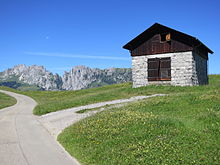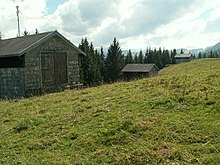Jaunpass artillery plant

The Jaunpass artillery was a defensive position for the Swiss Army . It is located at the top of the Jaunpass (1509 m), which connects the canton of Friborg with the canton of Bern .
Strategic importance
The Jaun Pass connects the region Gruyere (Freiburg) with the Simmental (Bern) and thus put military a key position at the entrance to the Swiss Reduit represents.
There are further artillery works and bunkered barriers on the axis mentioned .
- Charmey : La Tsintre lock
- In the catch : Infantry factory in the catch
- In catch: Gross Tosse artillery plant
- Artillery Euschels (7.5 cm)
- Jaun : Jaun blocking point
- Lock point Wimmis-Stockhorn
history
From 1941 the 7th Mountain Infantry Regiment formed the Jaun combat group . His order was to block the Jauntal axis from Broc and the axis from Schwarzsee over the Euschelspass to Jaun and to prevent an advance on the Jaunpass . The construction of the reinforcements in the area began very quickly after the positions were occupied. These bunkers and fortresses were part of the Swiss reduit strategy. The funds were approved by the Federal Council .
The construction of the fortifications was planned and managed by the technical office of the chief of the engineering troops. Simple work such as B. Excavations were carried out by the troops themselves. Blasting and engineering was taken over by civil construction companies. The troop commanders were deliberately not included in the planning; it was said that the troop commander had to take over the facility as it was built and then incorporate it into his tactical considerations to the best of his knowledge and belief. If the commanders had a say, all too often after a change of command the new commandant would not agree with the statements of his predecessor and would like changes.
A peculiarity at that time was that the bunkers were in the area of the 2nd Division (BE), but their targets were in the area of the 1st Division (FR). One explanation would be the topographical conditions of the 2nd division in the Simmental : With the cannons from the Jaunpass one could only work insufficiently into the Simmental.
After the Second World War , the artillery bunker on the Jaunpass was used for sniper exercises in the formation, as most of the works around Lake Thun were in the residential areas.
The Association of Artillerymen and Train Soldiers of the Sense District acquired two of the eight artillery bunkers on the Jaunpass in 2001.
plant
The plant had eight (two batteries ) 10.5 cm casemates , which were camouflaged as alpine huts and stand freely on the alpine meadows. Four batteries are located on the right (army designation A 1711–1714 east) and left (A 1715–1718 west) of the pass road, before and after the top of the pass towards Jaun . Each bunker (gun post) was autonomous for shooting and connected to the battery fire control center by cable.
The bunkers were built as a monoblock and offered the gun crew and the weapon system protection from enemy action. The positions were not connected to one another by a tunnel system in which the crew could have moved safely. The exposed location also represented a high risk of being recognized by the enemy very early on. The bunkers would have been exposed to practically no protection against a possible air attack.
- Telephone switchboard shelter A 1710 ⊙
- 10.5 cm artillery bunker A 1711 ⊙
- 10.5 cm artillery bunker A 1712 ⊙
- 10.5 cm artillery bunker A 1713 ⊙
- 10.5 cm artillery bunker A 1714 ⊙
- 10.5 cm artillery bunker A 1715 ⊙
- 10.5 cm artillery bunker A 1716 ⊙
- 10.5 cm artillery bunker A 1717 ⊙
- 10.5 cm artillery bunker A 1718 ⊙
literature
- VH + MA annual books of the Association of Historical Military Plants Freiburg-Bern
- Freiburg People's Calendar, 2005 edition, Military fortifications in the Sense and Gruyère Oberland, By Jürg Keller Brigadier retired and Marc Ramel Candphil I University of Freiburg, pages 81–89



